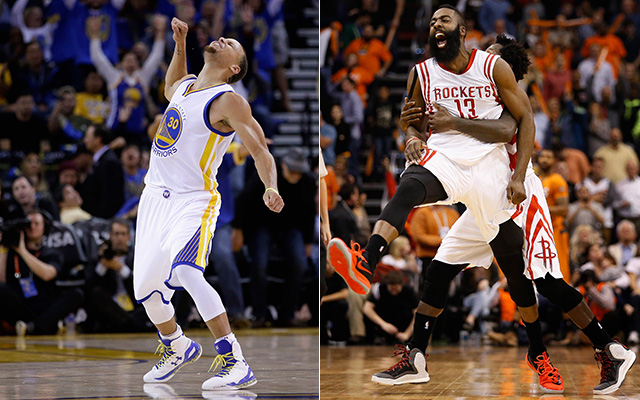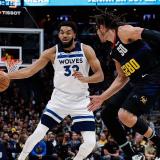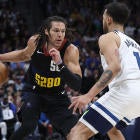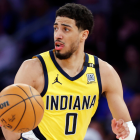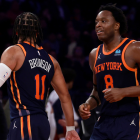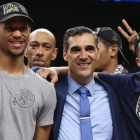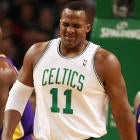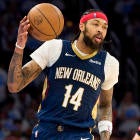Two men enter. One man gets a KIA.
The MVP race is down to two players -- James Harden and Stephen Curry-- (as I made the case for on Tuesday) and man alive, is it close. It's not just that these two players each are logging phenomenal performance after phenomenal performance, or that their statistic profiles are something out of a video game set on "rookie" mode, or that their highlights make the Vine loop counters go off like slot machines.
It's that they are so close in so many ways, and the arguments are so compelling. Best player on best team in the best conference. Kept the Rockets top-four in the West without Dwight Howard for most of the year. Dynamic scoring. Huge shots. Mind-boggling passes. Killer handle. Big games. Big games. Big games.
Everyone has an opinion and most of them are polarized. "It has to be Harden, look at how good they've been without Dwight!" "It's clearly Steph, he doesn't even play 4th quarters!" "Harden dropped 51!" "Curry is singularly unstoppable!" "So is Harden!"
I don't get a vote. But I want to know what the right answer is for the voters that do.
So over the next two weeks, we'll look at the MVP race between these two in earnest, and try and break it down to the microscopic, and then build it back up to the big picture. We'll cover scoring, passing, defense, and intangibles. Today we begin with what both of these players do best: get buckets.
For the purposes of this discussion we're trying to isolate and dissect these factors. So you're not going to see mentioned how Harden is carrying the Rockets without Howard or the Warriors' gaudy win totals. We'll get there in subsequent measures, I promise. But for right now, this just looks at their ability to score.
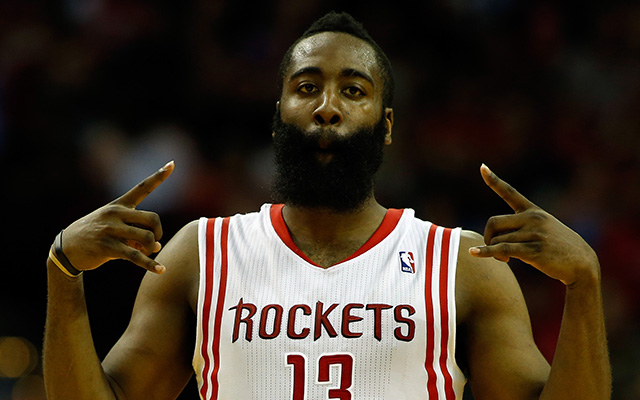
JAMES HARDEN: BEARD SCIENCE
James Harden shoots a lot of free throws.
Rockets fans hate this assessment of their star's game. It's meant to take something away when it's discussed; as if these points are given, not earned, as if drawing contact isn't a skill that took Derrick Rose from good to great in 2011, or the Spurs haven't perfected to earn easy points and slow the game down for years. It's thought of as a manipulation, the exploitation of the game's intent to prevent illegal contact upon players. It's an unfair assessment, but it's also not, on the surface, inaccurate.
He does shoot a lot of free throws. A lot.
Harden is first in made free throws, and first in free throw attempts. He's taken 752 free throws this season. The second-most free throws? Russell Westbrook's 582. Harden has taken 170 more free throws than the second-highest player. That's a staggering number.
(However, to put this in historical context, Wilt took 1,363 free throws in '62. Jordan, West Barkley all finished with significantly more than Harden will. So let's chill on the idea that Harden is doing something that never would have gone on in the old days. Also of note, Harden is actually behind Russell Westbrook in free throw attempts per 100 possessions. So again, not something that Harden's alone in, here.)
But Harden's game is so much more than free throws.
The first thing you should know is that Harden's an amazing shot maker. He just hits impossibly tough shots and does it regularly. On shots with a defender closer than four feet, Harden shoots 44 percent from the field. And when he does it, it's just demoralizing for the opponent. That's part of why Harden is tied with Westbrook in points per game this season at 27.6 per contest.
Watch Harden's patience here on the jab step. He catches this and instead of shooting when open, he uses his size and hip strength to clear space, and slowly gets his defender just far enough away to get the shot off. It's contested, but Harden's shot release is so fast, it makes it impossible to really bother him. He's unflappable.
His dribble drive terrifies opponents. He's so quick, and so strong, that he's physically just hard to stop. But his moves are also subtle. Look at how he's able to look like he's going into a crossover, short it, and then just switch back the other way.
This is Harden's bread and butter. He wants to get to the middle, to draw contact, to get to the line, but he's also a heck of a finisher in traffic. To get there, he uses that jab step to amazing ability. Here, Tony Allen, a first-team-All-Defense-worthy defender, just takes one innocent swipe with his right hand and overplays to Harden's left for a second. Again, Harden shorts the crossover, not going fully into the second-jab step and instead bursting to the rim. Harden has an unnatural ability to feel the defender biting on whatever one of the 18 moves he employs and immediately, instantaneously counter it with a move that punishes the reaction.
Harden spends 27 percent of all his possessions in isolation this season, more than LeBron James, the most in the league. In a set that is defined by its inefficiency, Harden makes it crazy efficient, averaging 1.03 points per possession via Synergy Sports in ISO sets. He does this in a number of ways. He's patient, he's versatile, yes, he draws fouls, but mostly it's that he's deliberate. There's no recklessness from Harden. He's not fearlessly charging in half-cocked. He reads the defense, takes his man off the dribble and either hits the pull-up, gets to the rim, or gets fouled.
Even more maddening for his defender, if you manage to stop Harden on his initial drive attempt, Harden's pet move is to reset, at which point you relax... and he punishes you.
That's just cold.
If you do manage to hang with his first arsenal of moves, and not get lost in his crossover, and your help defense is there to deter his drive to draw contact, and you force a tough fadeaway... then again, his shot-making ability takes over.
Harden's a lot more crafty than he's given credit for, and not just in drawing whistles. Watch him direct the weakside screen, whether legitimately or as a decoy. His defender checks over his shoulder for a second and then overreacts to his right, which gives Harden a red carpet path to the rim.
Harden's transition numbers aren't as good as you'd think they are. He's only in the 56th percentile in transition, compared to 89 percent in isolation and 91 percent in pick and roll according to Synergy Sports. But his change of direction is still something teams struggle with. Toronto literally falls into each other trying to stop him here. (Watching these clips of Toronto guarding Harden and realizing they won the game without Lowry is shocking enough to stop a herd of oxen in their tracks.)
You can believe that Harden chases calls, but you also need to recognize that this season, much more than last year, he's looked to finish through contact. Harden charges into four players here, which typically is a bad move, but he's got them off-guard in transition, hits another gear, and gets right to the rim. He wants the call he doesn't get here, but he still finishes.
Now, let's talk about fouls.
Flops drive me nuts. Always have. And way more so than defensive ones, the offensive type make me totally lose it. Simulating contact, falling to the ground in order to earn free points when you could not, would not make a shot, seems diametrically opposite to the point of basketball. Manu Ginobili is the lord and master of this. You can bring me Vlade Divac, you can trump Chris Paul or Blake Griffin or Harden, but no one brought the offensive head-snap-and-flail like Ginobili.
But you have to respect it. It is a skill. And Harden, like Ginobili, is very, very good at it.
The foul's impact goes way beyond the points. It limits opposing rotations, forcing coaches to take good defenders out and replace them with worse ones due to foul trouble. It slows the game down, giving Harden and the Rockets' offense a chance to breather. The Garnett-Era Celtics used to do this all the time. Draw a foul, lie on the ground as if hurt for a minute (Rondo was the kind of this), then pop back up and drain two free throws as if it were nothing. It gives your veteran teammates the chance to catch their breath, and to dictate the flow of the game.
Harden spots Ian Mahinmi trying to jump under the screen, here, reverses course (those hips, again), and gets to the middle. With Mahinmi off-balance and back-peddling, Harden doesn't try and get around him, he goes right into him. Then he uses the lean, his most dangerous weapon to draw fouls, going nearly horizontal in a motion that looks like a legitimate attempt to get a shot off, but is really a mechanism to exaggerate contact and elicit a foul.
This one's more subtle. Faried takes a bad angle here. But watch in slow-motion as Harden adjusts his course to the rim, moving his leg into Faried to create the bump. He doesn't go into the shot immediately, he legitimately tries to finish through it; that's an improvement over last year.
The other mechanism he uses to draw those calls is the Eurostep (those hips again!). Harden basically teleports horizontally across the court when he does this, and he occupies so much space as he does it, trying to contest the shot while avoiding a foul is like trying to knock a fly off a Buick windshield without touching it.
Harden's offensive game is versatile, efficient, maddening, and when he gets hot, there is nothing you can do. We'll talk about his efficiency relative to Curry in a little bit. But first and foremost, you need to know that Harden is more than free throws, he earns those free throws, and his offensive game is MVP-worthy.
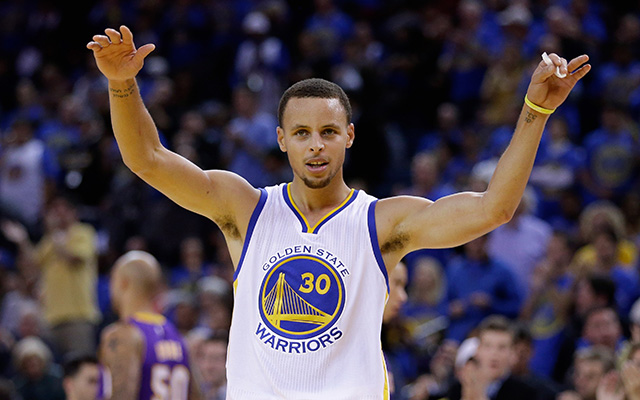
STEPHEN CURRY: FIRE WALK WITH ME
The Human Torch. Chef Curry with the pot. Splash Brother No.1. Steph Curry is his own #LeaguePassAlert and this season has been one for the ages. Finding his actual scoring impact is compelling this year, because Curry simultaneously may be the most unstoppable scoring force in the league this season and is close to having a down year for himself. He's scoring fewer points per game, in large part due to his fourth-quarter absences (he's posted a career-high in points per 36-minutes at 26 points, and per-100 possessions at 35.3). He's rebounded form a slow start to the year to post his best field-goal percentage in a season he's played over 50 games and the second best 3-point percentage in such years.
Curry was actually shooting below 40 percent from 3-point range -- and I like how for Curry, this mark that is stellar for everyone else is the expectation -- before the All-Star break. Since then? 51.4 percent from beyond the arc and excuse me while I throw up in this baseball cap.
Those are all numbers. But when we talk about Curry in the context of the MVP, one element remains with me more than any other.
Curry changes the context of the defense with his shot-making abilities in a way no other player... no other player does.
Curry doesn't have to be in balance. He doesn't' have to be set. He doesn't have to be square. He doesn't have to be open. He, quite simply, just has to have the ball.
So that's gross. The most deadly thing the Warriors have uncovered with Curry is how to engage him in pick and roll at near half-court in transition. It's part of why he scores .969 points per possession in pick and roll situations via Synergy Sports, which puts him in the 92nd percentile.
Curry's a mile away on this, and not square up to the basket. And he hits it cold. This isn't a heat check, this is a normal Curry shot.
Curry's transition numbers are even more bonkers. The Warriors have the fastest pace in the league this season, but Curry shoots 56 percent on the move despite high usage. Because he's able to hit shots like this:
Notice how in transition, Curry, unlike Harden and a lot of players, doesn't try and get to the middle as much as possible. Curry's first move, each time, is to move to the wing, and look for that transition 3, whether it's off a screen or pull-up.
Oh, and he does stuff like "coast to coast, rotate the ball around his back, finish at the rim" like it's nothing.
Curry's decision making is so quick. His crossover on CP3 the other night got all the press, but Curry put the moves on Paul earlier this year as well. When you get the scouting report on Curry and you're terrified of his pull-up three... he's learned to make you pay.
That mid-range jumper, yes, it can be efficient in the right hands, is something Curry actively seeks out in transition. He nails a ton of shots in just this manner. Remember how Harden punished the defense for relaxing after he reset in ISO? Curry does the same thing in transition. After the defense jumps to cover his transition pull-up 3-pointer, then pulls back to protect the drive, Curry takes advantage and boom.
Curry's handle is obviously the stuff of legend, but it should be noted that everything that Curry does with the ball, no matter how spectacular, is always designed at creating the best shot. He's never dancing to show up his opponent (even if he's fine with that result) and he's never indulging himself. He uses it to shake defenders and set himself up for shots he can hit.
But sometimes, it does just seem mean:
The way to stop Curry used to be to dog him at half-court, trap him as much as possible, prevent the transition three, and give him the rim if necessary. Curry shot a great 60 percent in the restricted area and good 57 percent inside five feet last year. This season? 66 percent in the restricted area and 60 percent within five feet. Curry's layup was always a bit of a weak point, until he started turning everything into basically a floater from short-range. He made them into more shot-like layups. And the result is devastating. The Thunder here basically try and "sheepdog" Curry up the court, and he just slips around all of them.
Again, watch his shot-form on this. He moves to the reverse more often than not now, and flips the ball up like a reverse floater. He's somehow more efficient with a more difficult shot. That's the most Curry thing I can describe.
For years I've marveled at Curry because he literally breaks basketball wisdom. Contested pull-up shots should be low-percentage, spot-up open shots should be high-percentage. Curry shoots 43.2 percent this season on spot-up attempts, via NBA.com. He shoots 44.1 percent on pull-up jumpers. He's literally better shooting off the dribble. With a defender less than two feet from him, he shoots 47.9 percent this year. With that defender 4-6 feet away? 46.5 percent. (He shoots 49 percent with the defender more than six feet away, because, I mean, that's a practice shot.)
When you have a player who takes the worst shots and makes them the most efficient, who you have to guard at half-court and who can create any shot he wants? That changes the defense in ways that creates complete havoc. And that may be most valuable.
SO... WHO'S BETTER?
Again, I want to say that they are both phenomenal players. And that scoring is by no means the end of the MVP conversation. We'll talk about how these two players make their teammates better next time. In 2011, when the race was this close, I advocated for a split-vote between Derrick Rose and Dwight Howard. However, most of that race was about how there wasn't a clear-cut winner. The same is true in 2015, but the stakes are so much higher, the level of play, honestly, so much higher, that it deserves an answer.
It's painful to decide. It's difficult to parse. There are strong points to both sides.
javascript:mctmp(0);But as far as scoring goes... it's Curry.
Here. Take a look.
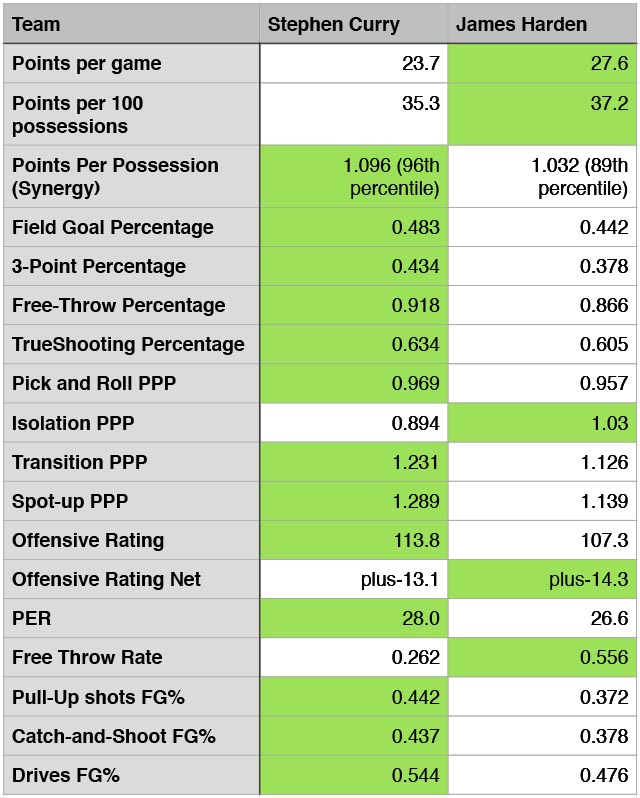
(Data provided by NBA.com, Basketball-Reference, and Synergy Sports. Catch-and-Shoot only provides for shots made immediately off the catch via SportVU data on NBA.com, spot-up points per possession covers points created by drives off spot-up and free-throws drawn off such plays.)
Of the 18 elements related to scoring I surveyed here, Curry has a significant advantage in 13 of them. PER isn't a great measure of scoring impact; it's influenced by shot volume, rebounding, and turnovers), but I thought it was relevant just from the efficiency standpoint. Offensive rating isn't the direct result of each player's scoring ability, but their scoring efficiency does provide a major input on it.
Thirteen out of 18 categories going in Curry's favor? With points per possession only moving into Harden's column and out of "too close to call" because of his 51-point performance Wednesday? Harden scores more points. Curry does it more efficiently, does it in a wider-range of ways, alters the defense in more substantial ways (barely, and I mean barely), and passes the eye test as a more dangerous scorer (again, barely). Here's the visualization of what they do from the floor, from Basketball-Reference.com.
First, Harden:
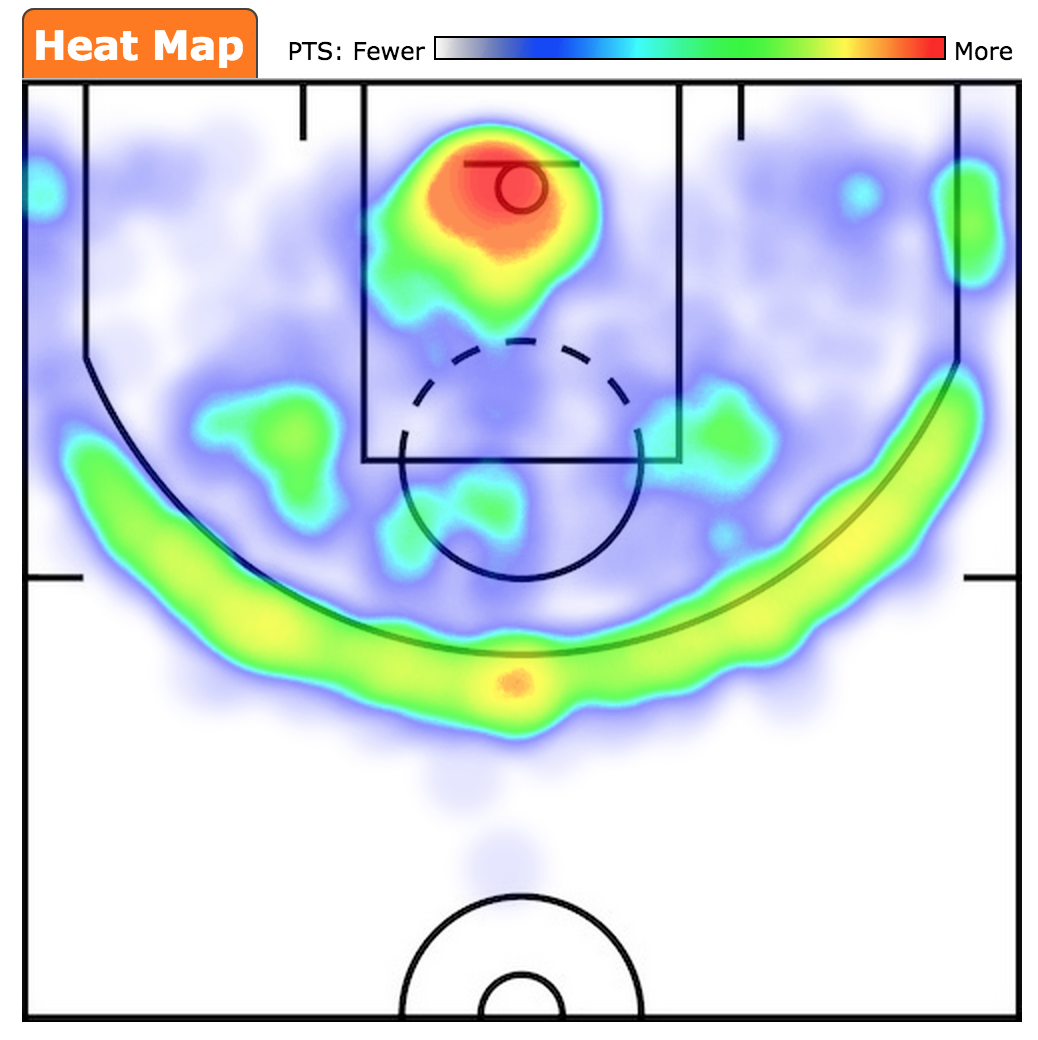
And then, Curry:
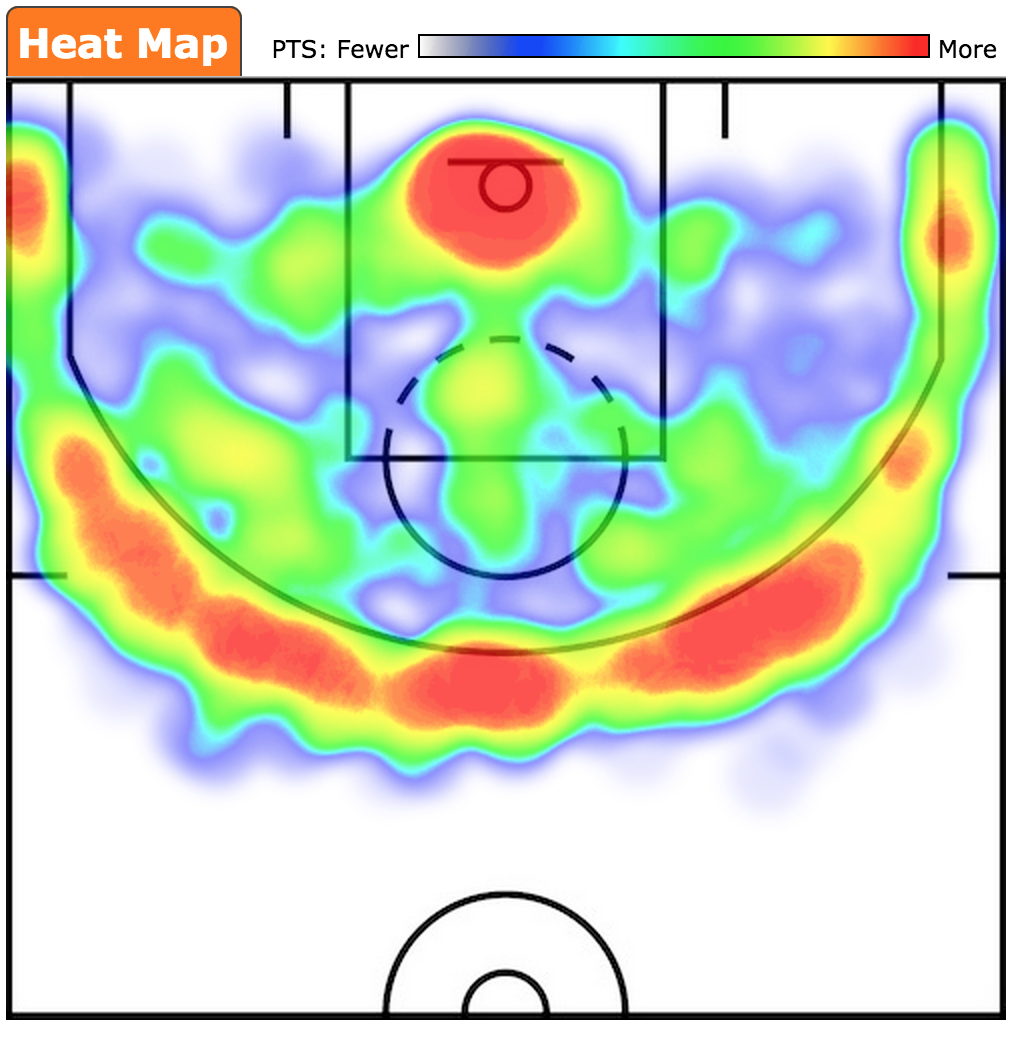
There's more to the MVP than scoring. But for two players whose primary identity is crafted by their ability to create points and score buckets, Curry wins this category. It's not decisive, but it is fairly clear. I can be talked into Harden being more important to his team, or having had a more impressive impact on wins. We'll get to all those things later.
But first and foremost, when we talk about the MVP, Stephen Curry is the best scorer in the league this season.
